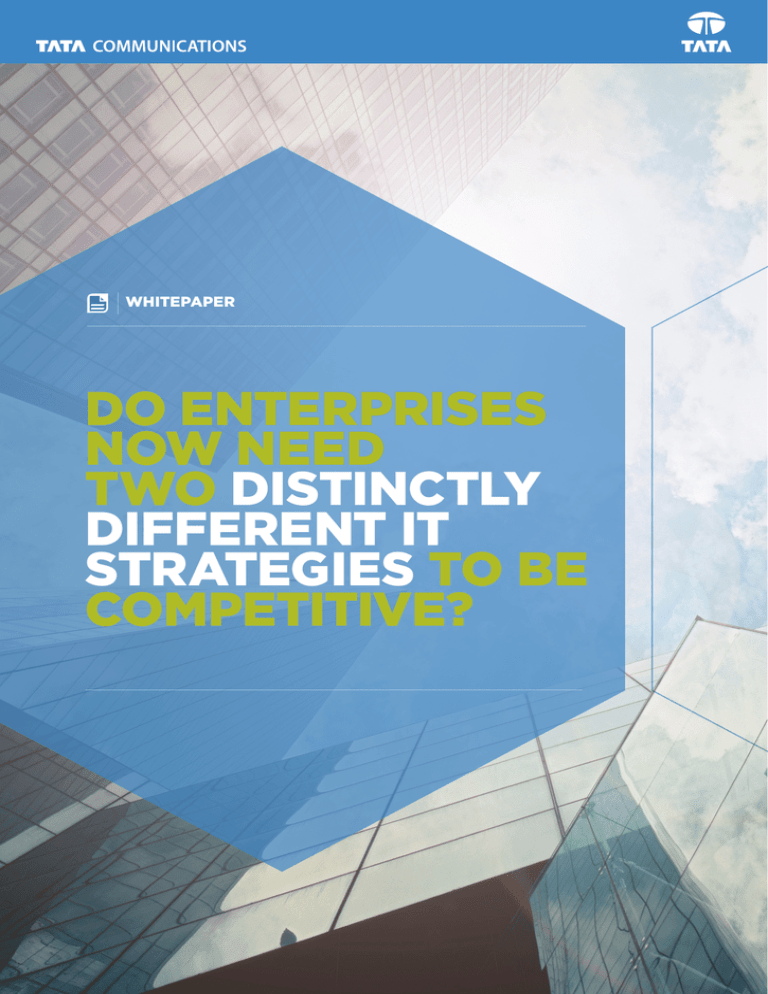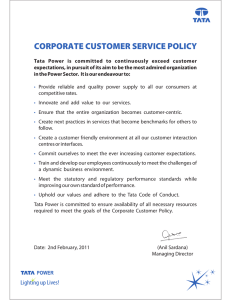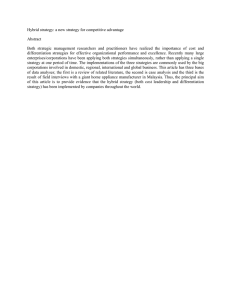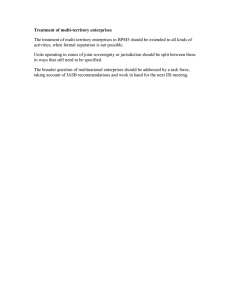
WHITEPAPER
DO ENTERPRISES
NOW NEED
TWO DISTINCTLY
DIFFERENT IT
STRATEGIES TO BE
COMPETITIVE?
IS TRADITIONAL IT ON A COLLISION COURSE WITH
THE FUTURE?
Digital transformation and the Internet are revolutionising enterprise
communication, collaboration and computing. New digital business models
based on nothing more than a concept and software code are disrupting
traditional versions around the world. In response, many enterprises are
establishing new, aggressive and innovative business units to ignite an
entrepreneurial fire and respond faster to new opportunities.
As a result, many of today’s entrepreneurial start-ups are being launched
not inside the proverbial garage, but within business units of large global
enterprises. The people working in them have a new mandate – collaborate,
innovate and help the enterprise gain competitive advantage.
These new business units are driving enterprise innovation by leveraging new
analytical tools, cloud and outsourced technology services. A major challenge
for them has been operational obstacles – getting the fast response they
need from IT. The issue is a clash of cultures and priorities. IT operations are
traditionally highly structured and measured – not especially focused on
flexibility and agility, which is what these new and aggressive business units
need. The collision of these diverging priorities has led business units to
essentially go their own way and seek IT solutions outside the control of the IT
department.
Enterprises are
rushing to leverage
value from mobile,
cloud, analytics and
the Internet of Things.
This is creating a
widening digital
divide between what
their IT organisations
can provide and what
enterprises need.
The answer may be
a new IT model that
combines stability
and agility.
A NEW IT MODEL FOR TODAY’S WORLD
In today’s hyper-competitive global market, enterprises needed a more flexible
and agile approach that enables them to respond faster to new opportunities.
The traditional IT model was born in the 1950s and 1960s – a world without
digital technology and the Internet. The velocity of business was incredibly
slower than today. Here’s just one example. On December 1, 1964, the trading
volume on the New York Stock Exchange was less than 5 million shares. Today,
it averages well over 1 billion shares and often exceeds 2 billion.
Now, with the ubiquitous Internet and digital transformation, the pace of
change is accelerating at warp speed. Enterprises, large and small, cannot
afford to wait months to implement new initiatives and solutions. That’s why,
in addition to the traditional IT model, today’s enterprises need a new and
separate IT fast-track model – Hybrid IT.
HYBRID IT: A FRESH IDEA THAT HAS BEEN AROUND
FOR YEARS
For some time, enterprises have been trying to make multiple models of IT
work together – sometimes successfully, sometimes not. There have been
legacy versus emergent systems, Brownfield versus Greenfield deployments,
and sustaining versus disruptive technologies. Each model has always required
a different kind of IT management and governance.
In response to increasing go-to-market pressure, two fast-track development
concepts were created in the first decade of the 21st century – DevOps and
Agile Development. DevOps is the idea that operations and development
engineers need to collaborate during the entire product development life
cycle. The objective is to accelerate development, increase product quality
and reliability, and ensure the desired outcome. Likewise, Agile Development
is positioned as an alternative to traditional project management, empowering
people to collaborate and make team decisions in a process that includes
continuous planning, testing and integration. Both DevOps and Agile
Development set the stage for the emergence of Hybrid IT in the enterprise.
© 2015 Tata Communications. All Rights Reserved. TATA COMMUNICATIONS and TATA are trademarks of Tata Sons Limited in certain countries.
2
THE TRANSITION TO HYBRID IT
As with any change, the move to Hybrid IT requires a thoughtful, step-by-step,
risk-mitigated approach – not a great leap forward. Several key decision points
in the process include:
• What are the best transition
methodologies to follow?
• What’s kind of infrastructure
is needed?
• Where should different kinds of
workloads run?
• What kinds of tools are
required to manage this new
environment?
• How will the enterprise develop
new application models for this
new paradigm?
• Where should different kinds
of data be stored?
There are a number of best practices that will help enterprises answer these
questions - and better manage the transition.
DETERMINE WHICH IT MODEL MAKES THE
MOST SENSE FOR A PROJECT
Deciding which model to use on a project – traditional or fast-track – often has
more to do with company culture than anything else. Some corporate cultures
demand that every detail be worked out before making a move. Others favour
moving fast, rather than agonising over every potential flaw. The takeaway:
determine which camp your enterprise aligns with and move ahead at the
appropriate pace, cautiously or quickly.
Traditional IT or
fast-track IT often
has more to do
with the company
culture than
anything else. The
objective is to use
the best approach
to solve the business
problem, with each
solution deployed
in the optimal
infrastructure –
saving time, money
and resources.
DEFINE THE OUTCOME TO MEASURE SUCCESS
Success for fast-track model projects isn’t measured in the same way as
traditional model projects. Fast-track versions are exploratory and may not
have a set list of capabilities at the start. With this approach, one typically
identifies the desired outcome and builds the business case before beginning
the project. Such a case might be to “improve lead generation by X% through
better segmentation of marketing campaigns.” The outcome defines the scope
and meeting the scope determines completion, rather than just meeting a list
of requirements.
MANAGE THE TRANSITION PROCESS
Instead of forcing every enterprise IT need into the same model, Hybrid IT
allows different workloads to be handled differently. The objective is to use the
best approach to solve the business problem, with each solution deployed in
the optimal infrastructure – saving time, money and resources. Your corporate
culture and politics have a powerful influence on the outcome of this effort.
You’ll likely start small, with one or two pilot projects that include both modes.
You’ll want to see how a fast-track model project works in parallel, openly and
collaboratively, with traditional model projects. In time, the Hybrid IT model will
refocus IT on three key areas of transformation:
1.New ways of designing, developing, and deploying applications
and services using: cloud services; distributed, fault-tolerant system
architecture; and agile, DevOps methodologies.
2.Business applications amenable to new architectures, iterative feature
development and fast release cycles.
3.IT skills required to work within the agile/cloud environment and which
successfully implement the resulting applications and services.
© 2015 Tata Communications. All Rights Reserved. TATA COMMUNICATIONS and TATA are trademarks of Tata Sons Limited in certain countries.
3
THE CHOICE IS YOURS
Depending on business needs, future plans and the competitive environment,
some enterprises will determine that staying with the traditional IT model is the
best choice in the short term. Other enterprises in highly competitive global
sectors will decide that migrating to Hybrid IT as quickly as possible is the key
to increasing agility, gaining market share and increasing profits. Whichever
path your enterprise chooses to take, it may not want to go it alone. That’s
where a trusted and experienced partner can help.
After many years of working with and serving the communications and IT
needs of a wide range of global enterprises, we understand that change
management is a complex process. And we know that there are a number
of issues to consider and manage during the transition:
Migrating to Hybrid
IT as quickly as
possible is the key
to boosting agility,
gaining market
share and
increasing profits.
• Applications: A large enterprise can have 500 or more applications
running through its IT infrastructure. You will need to compile an inventory of
them all, determine which ones are still useful and group them according to
the appropriate IT model – traditional or fast-track.
• Clouds: Most enterprises also have multiple clouds in their IT system: leased,
private, public and hybrid. Many enterprises have no idea what their clouds
are doing or how well they are performing. Again, you will want to take a
cloud inventory and determine what services and applications are running
in each.
• Software: Many large enterprises are using open source technology to launch
their Hybrid IT transformational journey. The goal with open source is to
increase flexibility and control, avoid vendor lock-in and mitigate expensive
licensing costs. Many also see it as a way to realise application portability
and interoperability – a ‘design-once, run anywhere’ approach. There are
many benefits to using open source software. It’s free. It can be customised.
And it means you’re not locked into a vendor or proprietary standards. You’ll
want to determine the best way to incorporate various open source solutions
into your IT infrastructure based on licensing, compliance and supportamong other criteria.
Today, as you plan your optimum path to Hybrid IT, consider the advantages of
working with an experienced and trusted partner who will help guide the way.
As a global leader in communications and networking, Tata Communications
can provide the expertise, scale, technologies, services, and IT infrastructure
your enterprise needs to safely, efficiently and cost-effectively make the
transition.
Currently, we are working with a number of enterprises to help them find the
most productive way forward. Let us show you what we can do for you. For
details and answers to your questions about moving to Hybrid IT, please email
dc.services@tatacommunications.com
For more information, visit us at www.tatacommunications.com/IZO
Contact Us
Share
© 2015 Tata Communications. All Rights Reserved. TATA COMMUNICATIONS and
TATA are trademarks of Tata Sons Limited in certain countries. 24048 v01




